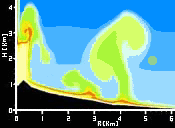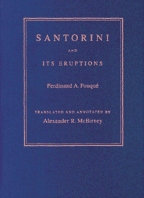
PD Dr. Ulrich Knittel:
Vulkanismus.de
Buchbesprechung
| zurück zur Startseite |
| Virtuelle Vorlesung zum Thema Vulkanismus |
| Entstehung von Magma |
| Mount Saint Helens |
| Homepage Taal (Philippinen) |
| Steffeln-Kopf (Westeifel) |
| Buchbesprechungen |
| |

by Ferdinand A. Fouqué,
translated into English by
Alexander McBirney
John Hopkins University Press
99.00 US $
88,50 Euro bei amazon.de
ISBN 0-8018-5614-0
Order the book!
- german review -
This is the English translation of the book 'Santorin et ses éruptions' by Ferdinand A. Fouqué published in 1879. It is a classical work of the volcanological literature. The translation was carried out by Prof. Alexander McBirney, who himself is a well known volcanologist and author of at least one book on volcanology - a combination rarely found among the translators of German-language scientific texts.
The book is subdivided into nine chapters, one of which is devoted to the historical activity and a second one specifically to the eruption of 1866, which happed at the time that Fouqué studied the volcano. Other chapters are devoted to the older structures of the volcanic edifice, and to the chemical and petrographic composition of the eruption products. Unexpectedly, one also finds a chapter describing the discovery of ruins and archaeological artefacts below the pumice beds of the bronze-age eruption. In view of this, the Book by W. L. Friedrich follows an old tradition (this book is also available in English).
This book is considered to be a classical study in volcanology, because it more or less finally laid to rest all theories that explain the origin of calderas by gigantic explosions rather than the subsidence of the roofs of magma chambers.
But also readers interested in archeometry will learn something new: already more than a hundred years ago Fouqué was able to show that the ancient pottery was made from clays that originated on the archipelago rather than being imported. He used the technique of thin section microscopy, a technique that had been introduced into the geological science merely 20 years earlier, to show that the clays contained fragments of volcanic rocks, identical to the rocks found on the islands.
To the modern reader, the text appears to be drawn out in places. However, it must be remembered that 19th century author had to rely much more on descriptions where modern authors use graphics. Also, in current books, older works are usually not cited in length. But in the present case, such citations are an advantage, because many of the old sources are no more readily available.
The translation is supplemented by numerous footnotes by McBirney, that explain aspects of the text, not obvious to the modern reader or introduce people long forgotten except to the specialist. An appendix provides of short, but very interesting review of the history of geological research on Santorini.
All in all, the book is a 'must' for fans of the Santorini archipelago, who also care for the history of its study. It is also commendable to those, who simply want to enjoy the very beautiful lithographs.
Dr. Ulrich Knittel